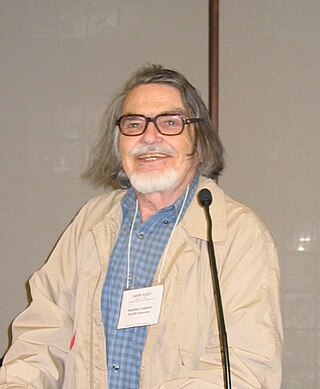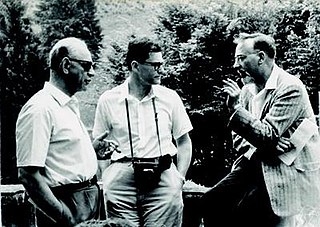Related Research Articles

In group theory, the Tits group2F4(2)′, named for Jacques Tits (French:[tits]), is a finite simple group of order

Norman Woodason Johnson was a mathematician at Wheaton College, Norton, Massachusetts.

Joachim "Jim" Lambek was a Canadian mathematician. He was Peter Redpath Emeritus Professor of Pure Mathematics at McGill University, where he earned his PhD degree in 1950 with Hans Zassenhaus as advisor.
In mathematics, a Ree group is a group of Lie type over a finite field constructed by Ree from an exceptional automorphism of a Dynkin diagram that reverses the direction of the multiple bonds, generalizing the Suzuki groups found by Suzuki using a different method. They were the last of the infinite families of finite simple groups to be discovered.
In mathematical finite group theory, the Thompson subgroup of a finite p-group P refers to one of several characteristic subgroups of P. John G. Thompson originally defined to be the subgroup generated by the abelian subgroups of P of maximal rank. More often the Thompson subgroup is defined to be the subgroup generated by the abelian subgroups of P of maximal order or the subgroup generated by the elementary abelian subgroups of P of maximal rank. In general these three subgroups can be different, though they are all called the Thompson subgroup and denoted by .
In mathematics, the Brauer–Suzuki theorem, proved by Brauer & Suzuki (1959), Suzuki (1962), Brauer (1964), states that if a finite group has a generalized quaternion Sylow 2-subgroup and no non-trivial normal subgroups of odd order, then the group has a center of order 2. In particular, such a group cannot be simple.
In mathematics, George Glauberman's Z* theorem is stated as follows:
Z* theorem: Let G be a finite group, with O(G) being its maximal normal subgroup of odd order. If T is a Sylow 2-subgroup of G containing an involution not conjugate in G to any other element of T, then the involution lies in Z*(G), which is the inverse image in G of the center of G/O(G).
In mathematics, George Glauberman's ZJ theorem states that if a finite group G is p-constrained and p-stable and has a normal p-subgroup for some odd prime p, then Op′(G)Z(J(S)) is a normal subgroup of G, for any Sylow p-subgroupS.
In mathematics, especially in the area of algebra known as group theory, the term Z-group refers to a number of distinct types of groups:
Stephen Arthur Jennings was a mathematician who made contributions to the study of modular representation theory. His advisor was Richard Brauer, and his student Rimhak Ree discovered two infinite series of finite simple groups known as the Ree groups. Jennings was an editor of Mathematics Magazine and an acting president of the University of Victoria.
In mathematical group theory, a normal p-complement of a finite group for a prime p is a normal subgroup of order coprime to p and index a power of p. In other words the group is a semidirect product of the normal p-complement and any Sylow p-subgroup. A group is called p-nilpotent if it has a normal p-complement.
In the mathematical theory of automorphic forms, the fundamental lemma relates orbital integrals on a reductive group over a local field to stable orbital integrals on its endoscopic groups. It was conjectured by Robert Langlands in the course of developing the Langlands program. The fundamental lemma was proved by Gérard Laumon and Ngô Bảo Châu in the case of unitary groups and then by Ngô (2010) for general reductive groups, building on a series of important reductions made by Jean-Loup Waldspurger to the case of Lie algebras. Time magazine placed Ngô's proof on the list of the "Top 10 scientific discoveries of 2009". In 2010, Ngô was awarded the Fields Medal for this proof.
In mathematics, a signalizer functor gives the intersections of a potential subgroup of a finite group with the centralizers of nontrivial elements of an abelian group. The signalizer functor theorem gives conditions under which a signalizer functor comes from a subgroup. The idea is to try to construct a -subgroup of a finite group , which has a good chance of being normal in , by taking as generators certain -subgroups of the centralizers of nonidentity elements in one or several given noncyclic elementary abelian -subgroups of The technique has origins in the Feit–Thompson theorem, and was subsequently developed by many people including Gorenstein (1969) who defined signalizer functors, Glauberman (1976) who proved the Solvable Signalizer Functor Theorem for solvable groups, and McBride who proved it for all groups. This theorem is needed to prove the so-called "dichotomy" stating that a given nonabelian finite simple group either has local characteristic two, or is of component type. It thus plays a major role in the classification of finite simple groups.
In finite group theory, an area of abstract algebra, a strongly embedded subgroup of a finite group G is a proper subgroup H of even order such that H ∩ Hg has odd order whenever g is not in H. The Bender–Suzuki theorem, proved by Bender (1971) extending work of Suzuki (1962, 1964), classifies the groups G with a strongly embedded subgroup H. It states that either
- G has cyclic or generalized quaternion Sylow 2-subgroups and H contains the centralizer of an involution
- or G/O(G) has a normal subgroup of odd index isomorphic to one of the simple groups PSL2(q), Sz(q) or PSU3(q) where q≥4 is a power of 2 and H is O(G)NG(S) for some Sylow 2-subgroup S.
In mathematics, the Gorenstein–Walter theorem, proved by Gorenstein and Walter (1965a, 1965b, 1965c), states that if a finite group G has a dihedral Sylow 2-subgroup, and O(G) is the maximal normal subgroup of odd order, then G/O(G) is isomorphic to a 2-group, or the alternating group A7, or a subgroup of PΓL2(q) containing PSL2(q) for q an odd prime power. Note that A5 ≈ PSL2(4) ≈ PSL2(5) and A6 ≈ PSL2(9).
In mathematics, the Walter theorem, proved by John H. Walter, describes the finite groups whose Sylow 2-subgroup is abelian. Bender (1970) used Bender's method to give a simpler proof.
In finite group theory, a p-stable group for an odd prime p is a finite group satisfying a technical condition introduced by Gorenstein and Walter in order to extend Thompson's uniqueness results in the odd order theorem to groups with dihedral Sylow 2-subgroups.

Richard Hubert Bruck was an American mathematician best known for his work in the field of algebra, especially in its relation to projective geometry and combinatorics.
In mathematical group theory, the Thompson replacement theorem is a theorem about the existence of certain abelian subgroups of a p-group. The Glauberman replacement theorem is a generalization of it introduced by Glauberman.
Zdeněk Hedrlín was a Czech mathematician, specializing in universal algebra and combinatorial theory, both in pure and applied mathematics.
References
- ↑ Curriculum vitae, retrieved 2013-07-21.
- ↑ George Glauberman at the Mathematics Genealogy Project
- ↑ List of Fellows of the American Mathematical Society, retrieved 2013-01-19.